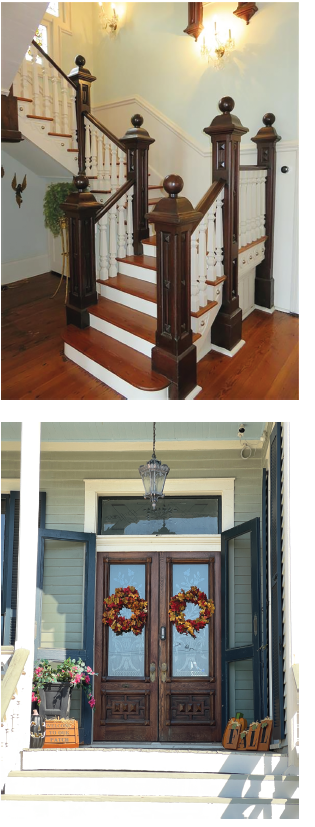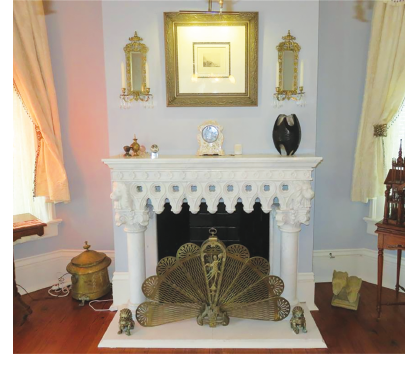One of the many admirable qualities of early Galvestonians was their resiliency. The East End Historic District stands as a testament to that trait.
A devastating fire swept across blocks of the greater downtown area in 1885, destroying homes from 16th to 20th streets and from The Strand past Broadway. This neighborhood was rebuilt into one of the island’s magical collections of architectural treasures.
Each of the intriguing homes in this district has hosted the lives and experiences of the people who dwelled in them, becoming part of the fabric of their history. The home built by Theodore Ohmstede (1833-1918) for his family at 1816 Postoffice Street in 1886 is no exception.
Ohmstede’s American Victorian-style residence featured a double-galleried front porch charmingly detailed with trim, a slate roof, walk-through windows to welcome the bay breezes, and electricity in every room. The 10 rooms included a formal parlor, dining area, central hallways, and five bedrooms.
Ohmstede immigrated to Galveston from Germany in 1858, fought in the Civil War serving in Waul’s Legion of the Confederate Cavalry, and became a naturalized citizen in 1872.
After the war, he worked for J. J. Schott & Co. wholesale drug company, then with Thompson, Schott and Company, before forming a partnership with Thomas C. Thompson to operate Thompson & Ohmstede Drug Store at the southeast corner of Tremont Street and Avenue A.
After a few years in the pharmaceutical business, he turned to banking and became an officer with The Rosenberg Bank. By 1890 his income permitted building an addition to the family’s home.
His wife Eleanora Brock (1857-1928) was one of two daughters of another German immigrant, Ernst Moritz Brock (1830-1882), who dealt in stoves and tinware. Brock and his wife Rosina Johanna Rinker (1828-1893), who created and taught fancywork embroidery and needlework for a living, lived at the far west end of Postoffice Street.
The Ohmstedes had three children: Theodore George Ohmstede, Jr. (1877-1915), Eda Ohmstede (1879-1964), and Anita Augusta Ohmstede (1886-1984).
Theo Jr.’s first job was as a collector for The Rosenberg Bank, where his father worked. By 1900, he was a junior salesman at F. E. Mistrot Dry Goods, located in the building where the Tremont House hotel is today. By the time his father retired, he worked in the auditor’s office at the Gulf, Colorado, and Santa Fe Railway, and still lived in his parents’ home.
In 1907, daughter Anita was summering in Canada when she learned that her school days sweetheart Randolph Lee Evans was seriously ill and rushed home to be with him. They were married by Trinity Episcopal Church’s Reverend Sloan in a small ceremony at the groom’s brother’s home on August 27, 1907. He passed away the following March, leaving his young widow, who moved back into her parents’ home to carry on without him.
Theo, Jr. suffered ill health throughout 1914 and his family sent him to the clinics and spas in Mineral Wells to receive treatment. The famous mineral spring waters at the site, called Crazy Water, were touted to have healing properties. Unfortunately, they could not cure his ailments, and on February 13, 1915, young Theo died in Mineral Wells at the age of 37.
In November of that year, Anita married John Wharton Bartholomew (1884-1981) in an evening ceremony at Trinity Episcopal Church in the presence of friends and family. As it was her second marriage, the bride wore a midnight blue suit with sable furs and a corsage of roses and lilies of the valley. The church was decorated with palms and a lighted seven-branch candlestick.
After a honeymoon in California, they returned to Galveston on Christmas Day. The couple later moved to Fort Worth, where Bartholomew became successful in the machinery business.
 Eda, the family socialite, was often mentioned in the newspapers as volunteering on committees with several local charities including the Y.W.C.A., and attending ladies’ functions around the island. She married Robert Norman Dumble (1877-1963), a meat packing business operator in Houston, in 1917.
Eda, the family socialite, was often mentioned in the newspapers as volunteering on committees with several local charities including the Y.W.C.A., and attending ladies’ functions around the island. She married Robert Norman Dumble (1877-1963), a meat packing business operator in Houston, in 1917.
 On March 27, 1918, Theodore Sr. died at the family home. His wife passed away on Christmas Day in 1928 in Fort Worth, where she had moved to be closer to their youngest daughter and grandchildren.
On March 27, 1918, Theodore Sr. died at the family home. His wife passed away on Christmas Day in 1928 in Fort Worth, where she had moved to be closer to their youngest daughter and grandchildren.
The next owners of the home on Postoffice were Julius Wilhelm Hoppe (1884-1953), a bookkeeper in a meat packing plant, and his wife Claudia Josephine Pettinati (1890-1944).
Hoppe was born in Leipzig, Germany and his wife was Italian. They immigrated to Galveston together in 1906, where they had a daughter, Lillian Bianca Hoppe (1915-1969), and a son, Julius W. Hoppe, Jr. (1918-1980).
Claudia was very active in the Italian community on the island, and held meetings of the Dante Alighieri Society in their home. The group gathered regularly to study the literature, arts, and language of her homeland.
The Hoppes sold their home to Charles Tuttle Long (1898-1966) and his wife Mary Elizabeth Holton Russell (1896-1962) in 1944. Russell was a young divorcee with two children from previous marriages when she and Long met in his hometown of Beaumont. They lived at the Buccaneer Hotel for several months before purchasing the home.
Long worked as a transport driver during World War II, and as a taxi driver and chauffeur before and after the war. He ultimately went into the real estate business.
Morris Schreiber (1901-1951), a jeweler from New York, and his wife Sonya Schuman (1908-1953), a Russian immigrant, purchased the Long’s home in 1948.
The couple built a one-story, flat-roofed building at the front of the property attached to the side of their home featuring a black-framed green tiled front, where Mrs. Schreiber opened Sonya’s Beauty Salon.
On the 1950 census, the couple had three boarders at the home: a shipping clerk at the cotton compress, a seaman, and a nurse at St. Mary’s Hospital.
After the couple’s deaths, their daughter Joyce Yvette Schreiber (1923-1977) and her husband Irving Leonard Moskowitz (1915-1987) moved into the house in 1954, along with their two daughters and Irving’s father Abraham.
In 1958 Joyce sold the house, which had been subdivided into four apartments, and the beauty shop to George Alexander D’Aquin (1905-1973), a mariner, and his then wife Thelma Smith.
D’Aquin and his second wife Mary Alice Rood (1904-1985) sold the property to John M. Lutin in 1964, and insurance papers two years later described the home as having been divided into nine apartments. That number seems unlikely unless it included basement level and carriage house apartments.
The small building constructed for Sonya’s Beauty Shop was rented as a professional office space until it was torn down in the 1970s, re-opening the home’s yard to its original appearance.
The house was graciously renovated in 1995, and again in 2009, and now stands as a beautiful part of the East End Historic District, holding the memories and stories of diverse generations of Galvestonians.